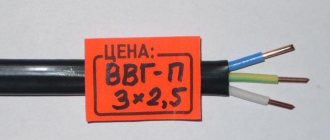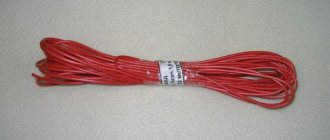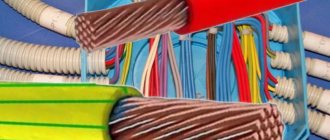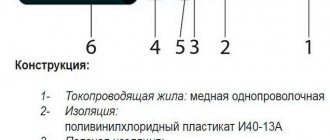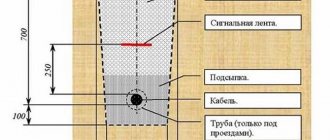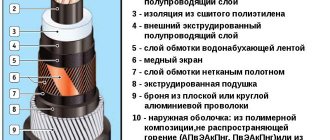- C - self-supporting;
- I - isolated;
- P - wire.
The letter at the end of the marking means:
- “A” - neutral core with insulation
- “H” - current-carrying conductors are made of aluminum alloy
- “T” - insulation resistant to elevated temperatures +90°C (short-term +120°C)
- “G” - sealed (moisture will not spread along the wire more than 3 meters from damage to the insulation)
In the marking of a SIP wire, a dash sign indicates the rated voltage for which the wire is intended. Sometimes two values can be indicated here separated by a slash. For example, 0.6/1. This means that the wire is designed for voltages of 660 or 1000V.
And the last thing in the marking is the technical condition according to which the wire is made. Usually this is a set of numbers after the abbreviation TU.
Cable marking, in addition to designating a specific group, also necessarily includes the wire cross-section, date of manufacture, batch number and additional information from the manufacturer.
Peculiarities
SIP is a self-supporting insulated wire, used for power supply in power networks. The SIP electric cable is used in a network with voltage: SIP-1, SIP-2, SIP-4 and SIP-5 are designed for a rated voltage of up to 1 kV, SIP-3 up to 35 kV.
Most SIP wires produced in Russia are color-coded in accordance with the PUE (Electrical Installation Rules) and the new GOST 50462-2009. The insulation of phase conductors and the supporting neutral conductor is made of thermoplastic polyethylene or silanol-cross-linked (light-stabilized) polyethylene, which can withstand temperatures of about 80-90°C for a long time
The technical characteristics of the SIP cable are regulated by GOST R 52373-2005 / GOST 31946-2012 / TU 16-705.500-2006, according to which self-supporting insulated wires include products for overhead lines with voltages up to 0.6/1 kV inclusive, and protected wires, products for the same lines, but with voltage up to 10 kV; from 10 to 20 kV; 20 kV and 35 kV. There are different types of SIP wire. Most often, SIP type cables are classified by cross-section: 4x16, 2x16, 4x50, 4x25, 4x35, etc. Also, the brand of wire is divided according to the type of core insulation and technical characteristics:
- SIPT-1, also known as SIP-1 - except for the zero core, all the rest are insulated with special polyethylene. SIP-1 is produced for 380 V networks. This is a four-wire cable made of aluminum or aluminum alloy, three cores are covered with light-resistant polyethylene, resistant to ultraviolet radiation, and the fourth without braid with a steel core acts as a carrier and neutral.
- SIPT-2 and SIPT-1A - all threads are isolated;
- SIP-2 - all cores (except for the zero wire) are insulated with cross-linked polyethylene;
- SIP-2A - all conductors, including neutral, are covered with a layer of cross-linked polyethylene;
- SIP-3 - a wire consisting of one conductive core, made of a dense alloy or steel-aluminum wire structure, the insulating layer is made of cross-linked light-stabilized polyethylene. SIP-3 is used for transmitting electrical energy with voltages up to 20 kV;
- SIP-4 - all four cores are insulated with thermoplastic polyethylene, but there is no separate load-bearing core. When laying and tensioning the line, all conductors carry the load, i.e. fastening is carried out immediately for all conductors;
- SIP-5 - does not have a separate load-bearing core, the rest are covered with a sheath of cross-linked (light-stabilized) polyethylene, the number of cores is two or more. They are used mainly in enterprises or for extending electrical networks in the city or between populated areas. It consists of insulated strands coated with polyethylene, where each strand is wrapped in a separate sheath. Types of wire SIP-4 and SIP-5 do not have a supporting zero core and can consist of two or more threads (most often 2 or 3).
Selecting wire insulation
In addition to the characteristics of the current-carrying and load-bearing cores, it is worth paying attention to the insulation of the wires, or more precisely to the material of its manufacture.
For regions with increased intensity of ultraviolet radiation, insulation made of light-stabilized polyethylene is recommended. If there is a risk of significant external heating during operation, it is worth giving preference to non-combustible insulation. If significant sudden changes in temperature are possible, or there is a risk of snow sticking or icing of wires, then in such conditions wires with thermoplastic insulation will be the most durable and work properly.
When operating in high humidity conditions, it is preferable to use sealed wires.
Application of SIP wire:
SIP-1 For mains of overhead power lines (OHT) and linear branches from OHL for rated voltage up to 0.6/1 kV inclusive, with a nominal frequency of 50 Hz in an air atmosphere of types I and II according to GOST 15150.
SIP-2 For mains of overhead power lines (OHT) and linear branches from OHL for rated voltage up to 0.6/1 kV inclusive with a rated frequency of 50 Hz in an air atmosphere of types II and III according to GOST 15150, including on the coasts of seas, salty lakes, industrial areas and areas of saline sands.
SIP-3 - For overhead power lines with a rated voltage of 20 kV (for networks with voltages of 10, 15, 20 kV) and 35 kV (for networks with 35 kV) with a nominal frequency of 50 Hz in air atmosphere II and III according to GOST 15150, including including on the coasts of seas, salt lakes, in industrial areas and areas of saline sands.
SIP-4 Designed for branches from overhead lines to the input and for laying along the walls of buildings and engineering structures for rated voltage up to 0.6/1 kV inclusive, with a nominal frequency of 50 Hz in air atmosphere II and III according to GOST 15150.
Production and sales
There are many cable manufacturers, and only the consumer can decide which wire to choose specifically from all the varieties. As for quality, it cannot be said that any of the large domestic or foreign manufacturers are significantly higher or lower in this indicator.
All requirements for SIP wires are presented in the relevant GOST, and if the products of a particular enterprise do not comply with it, they simply will not reach the market.
The manufacturer directly carries out mainly wholesale cable sales; for small volumes you will have to resort to the services of dealers or intermediaries. And decent companies are always ready to provide documentation confirming their cooperation with one or another manufacturer, as well as evidence of the quality of the product.
Mechanical characteristics of SIP wire
| Estimated outer diameter of the wire, mm" | Estimated weight of 1 km of wire, kg | ||
| SIP-1-0.6/1 | 1×16+1×25 | 15 | 135 |
| 3×16+1×25 | 22 | 270 | |
| 3×25+1x35 | 26 | 390 | |
| 3×35+1×50 | 30 | 530 | |
| 3×50+1×50 | 32 | 685 | |
| 3×50+1×70 | 35 | 740 | |
| 3×70+1×70 | 37 | 930 | |
| 3×70+1×95 | 41 | 990 | |
| 3×95+1×70 | 41 | 1190 | |
| 3×95+1×95 | 43 | 1255 | |
| 3×120+1×95 | 46 | 1480 | |
| 3x150+1x95 | 48 | 1715 | |
| 3×185+1×95 | 52 | 2330 | |
| 3×240+1×95 | 56 | 2895 | |
| SIP-2-0.6/1 | 3×16+1×25 | 24 | 308 |
| 3×16+1×54.6 | 28 | 427 | |
| 3×25+1×35 | 27 | 424 | |
| 3x25+1x54.6 | 30 | 512 | |
| 3×35+1×50 | 31 | 571 | |
| 3×35+1×54.6 | 32 | 606 | |
| 3×50+1×50 | 34 | 727 | |
| 3×50+1×54.6 | 35 | 762 | |
| 3×50+1×70 | 36 | 798 | |
| 3×70+1×54.6 | 39 | 973 | |
| 3×70+1×70 | 40 | 1010 | |
| 3×70+1×95 | 41 | 1087 | |
| 3×95+1×70 | 43 | 1240 | |
| 3×95+1×95 | 45 | 1319 | |
| 3×120+1×95 | 48 | 1553 | |
| 3×150+1×95 | 50 | 1787 | |
| 3×185+1×95 | 55 | 2403 | |
| 3×240+1×95 | 60 | 2968 | |
| SIP-3 -20 | 1×35 | 12 | 165 |
| 1×50 | 13 | 215 | |
| 1×70 | 15 | 282 | |
| 1×95 | 16 | 364 | |
| 1×120 | 18 | 445 | |
| 1×150 | 19 | 540 | |
| 1×185 | 21 | 722 | |
| 1×240 | 24 | 950 | |
| SIP-3-35 | 1×35 | 14 | 209 |
| 1×50 | 16 | 263 | |
| 1×70 | 17 | 334 | |
| 1×95 | 19 | 421 | |
| 1×120 | 20 | 518 | |
| 1×150 | 22 | 618 | |
| 1×185 | 24 | 808 | |
| 1×240 | 26 | 1045 | |
| SIP -4 0.6/1 kV | 2x16 | 15 | 139 |
| 4x16 | 18 | 278 | |
| 2x25 | 17 | 196 | |
| 4x25 | 21 | 392 |
Calculation method
We take plate 10 and from it we find that one core is 16 sq. mm. withstands - 100 amperes. And then the most important thing is how much should this 100A be multiplied by - by 220 or 380? Here we need to look from the point of view of consumers who will be connected to the sip. If this is an ordinary residential building, then there are not so many three-phase appliances (well, the only thing that comes to mind is an induction cooker or electric oven, although they are essentially 220V), if this is some kind of repair shop, then there is already more three-phase equipment (lifts, welding, compressor).
At the beginning of the topic, the question was raised: “will a 4x16 15kW sip handle it?” Therefore, for a private house we multiply 220Vx100A = 22 kW per phase. But don’t forget that we have three phases. And this is already 66 kilowatts
total for a residential building.
Which is a 4-fold margin
relative to the issued technical conditions.
The main purpose of SIP cables is to transmit electricity over overhead lines. The cable is actively used in the removal of electricity from main highways to residential and commercial buildings, and in the construction of lighting networks on the streets of populated areas.
Read also: Connecting a grounding plug by color
Self-supporting insulated wire (SIP)
Permissible current loads of insulated wires for overhead transmission lines (SIP)
| Nominal cross-section of main cores, mm2 | Permissible load current, A, no more | Permissible one-second short circuit current, kA, no more | |||
| Self-supporting insulated wires | Protected wires | Self-supporting insulated wires | Protected wires | ||
| 20kV | 35kV | ||||
| 16 | 100 | — | — | 1,5 | — |
| 25 | 130 | — | — | 2,3 | — |
| 35 | 160 | 200 | 220 | 3,2 | 3,0 |
| 50 | 195 | 245 | 270 | 4,6 | 4,3 |
| 70 | 240 | 310 | 340 | 6,5 | 6,0 |
| 95 | 300 | 370 | 400 | 8,8 | 8,2 |
| 120 | 340 | 430 | 460 | 10,9 | 10,3 |
| 150 | 380 | 485 | 520 | 13,2 | 12,9 |
| 185 | 436 | 560 | 600 | 16,5 | 15,9 |
| 240 | 515 | 600 | 670 | 22,0 | 20,6 |
How to choose a section?
The cross-section of the wire must correspond as much as possible to the power of the connected load. Wires that are too thin will have a higher resistance and, accordingly, become very hot, which leads to significant energy losses during transmission, and can also cause insulation destruction, short circuits and even a fire.
How to choose the right one? Regulatory documents and tables indicating voltage and current for different types of self-supporting insulated insulated wires will help you select a cable with the characteristics required by the consumer.
The key characteristic for choosing a wire is the current strength that can pass through it.
This indicator is different for different sections:
- 16 mm2 - 100 A;
- 25 mm2 – 130 A;
- 35 mm2 - 160 A;
- 50 mm2 - 195 A;
- 70 mm2 - 240 A;
- 95 mm2 - 300 A;
- 120 mm2 - 340 A;
- 150 mm2 - 380 A;
- 185 mm2 - 436 A;
- 240 mm2 - 515 A;
Proportionally, as the cross-sectional area increases, the maximum permissible current strength for which this wire is designed for the load also changes. In addition, wires of different sections can withstand different intensities and durations of heating during operation.
If the task is to supply electricity to the house using a sip pipe, it is important to choose the right option. Typically, a wire with a minimum cross-section of 16 mm2 is more than enough. Cables with a smaller cross-section are simply not produced, and larger ones are not needed for household energy consumption.
In a standard household power supply network, there are no significant overloads, and the ambient temperature does not go beyond - 50 - + 60 degrees.
How many kilowatts can a SIP withstand?
| SIP section | voltage 380V (3-phase load) | voltage 220V (1 phase load) |
| SIP 4x16 | 62 kW | 22 kW |
| SIP 4x25 | 80 kW | 29 kW |
| SIP 4x35 | 99 kW | 35 kW |
| SIP 4x50 | 121 kW | 43 kW |
| SIP 4x70 | 149 kW | 53 kW |
| SIP 4x95 | 186 kW | 66 kW |
| SIP 4x120 | 211 kW | 75 kW |
| SIP 4x150 | 236 kW | 84 kW |
| SIP 4x185 | 270 kW | 96 kW |
| SIP 4x240 | 320 kW | 113 kW |
Selecting a section and checking the product
When choosing a wire, you need to pay attention to its rated current. To determine the parameters of the required product, you should take into account the length of the network sections and the load that falls on them.
Before starting installation, be sure to check the integrity of all wires with a multimeter.
To do this, switch the toggle switch to the position of the resistance sector and the probes are black and red. In this case, a signal will be heard indicating that the dialing mode is active. Then you need to touch both ends of the SIP with the probes.
If the wire is not damaged, the multimeter will emit a signal, which indicates that the charge has reached from one end to the other. This manipulation should be carried out for each core.
Video
While browsing the internet for electrical installations, I found a thread on one forum discussing “whether a 4x16 sip can withstand 15 kW.” The question arises because 15 kW 380 volts are allocated for connecting a private house. Well, people are wondering if it’s not enough to lay 16 square meters on a branch from the overhead line? I first looked into the PUE, but for some reason I didn’t find anything there on the topic of SIP power. There is only plate 1.3.29 “Permissible long-term current for non-insulated wires according to GOST 839-80.” And it shows that the maximum permissible current for the cross section is 16 kV. mm. wire type AC, ASKS, ASK outdoors is 111 amperes. Well, at least something to start with.
Service cost
Of course, before going to specialists, everyone wants to know how much it costs to install a SIP cable? The amount of money you will need to pay for the work of professionals depends on several factors. First of all, from the city of residence: the closer to the capital or other large cities the house is located, the higher the cost of installing SIP cable will be. So, for example, for Moscow and the region, one of the capital’s companies lists the following prices for the installation of SIP cable: 1. With a wire cost of 80 rubles / linear meter. (SIP-4) and line length up to 100 m, for each linear meter you will need to pay 120 rubles. If the length of the line is from 100 to 500 m, the price of a linear meter of the line will be lower - 100 rubles, and with an even greater length of the line (from 500 to 1000 m) the cost of each meter is even lower - 80 rubles. 2. With a product cost of 125 rubles/linear meter. (SIP-2), the price per meter of SIP cable installation will be 140 (up to 100 m), 130 (up to 500 m) or 120 (up to 1000 m). 3. Installation of SIP-2 wires costing 245 rubles/linear meter. will cost 180/170/160 rubles respectively. In other words, the price of installing SIP cable is calculated in each specific case and depends on the following indicators: 1. Length of the line. 2. Wire sections. 3. Number of turns. 4. Number of connections. 5. Passages through walls. 6. Location of the object - SNT or city.
Design parameters of current-carrying conductors
| Nominal cross-section of current-carrying conductor, mm2 | Number of wires in the core, pcs. | Outer diameter of current-carrying core, mm | Nominal insulation thickness, mm, for wires of brands SIP-2, SIP-2A | Electrical resistance of 1 km of wire, Ohm, no more | ||
| phase | control | minimum | maximum | |||
| 16 | — | 1 | 4,35 | 4,45 | 1,3 | 1,91 |
| 16 | — | 7 | 4,60 | 5,10 | 1,3 | 1,91 |
| 25 | — | 7 | 5,70 | 6,10 | 1,3 | 1,20 |
| 35 | — | 7 | 6,70 | 7,10 | 1,3 | 0,868 |
| 50 | — | 7 | 7,85 | 8,35 | 1,5 | 0,641 |
| 70 | — | 7 | 9,45 | 9,95 | 1,5 | 0,443 |
| 70 | — | 12 | 9,70 | 10,20 | 1,7 | 0,443 |
| 95 | — | 7 | 11,1 | 11,7 | 1,7 | 0,320 |
| 95 | — | 19 | 11,0 | 12,0 | 1,7 | 0,320 |
| 120 | — | 19 | 12,50 | 13,10 | 1,7 | 0,253 |
| 150 | — | 19 | 13,90 | 15,0 | 1,8 | 0,206 |
| — | 1,5 | 1 | — | 1,5 | 1,2 | 12,1 |
Calculation example
An example of calculating the cross-section of a SIP cable for connecting an object with a total power of electrical appliances of 72 W, at a distance from the main power line of 340 m. Supports for hanging the SIP cable should be placed at intervals of no more than 50 m, this will significantly reduce the mechanical load on the wires. The maximum current for a three-phase circuit should be calculated when all electrical appliances are turned on. Provided that the load is distributed evenly between the phases, one phase will have:
72 kW / 3 = 24 kW.
The maximum current in one phase, taking into account the inductive and capacitive load of electrical appliances (cos fi = 0.95) will be:
24 kW / (230V* 0.95) = 110A.
According to the table, a SIP cable with a cross-section of 25 A is selected, however, given the cable length of 340 m, voltage losses must be taken into account, which should be no more than 5%. For ease of calculation, the cable length is rounded to 350 m:
- in SIP, the resistivity of aluminum is 0.0000000287 ohm/m;
- The wire resistance will be Rpr. = (0.0000000287 / 0.000025) Ohm/m * 350 m = 0.4 Ohm;
- load resistance for 24 kW. Rн = U 2 * cos fi: P = 230 2 * 0.95 / 24 kW = 2.094 Ohm;
- total resistance – Rtotal. = 0.40 Ohm. + 2.094 Ohm. = 2.5 Ohm.
Based on the calculated data, the maximum current in the phase conductor will be:
I = U / R = 230V: 2.5 Om = 92 A
The voltage drop is equal to I max * Rpr. = 93A * 0.4 Ohm = 37V.
37 Volts is 16 percent of the mains voltage U = 230V, which is more than the permissible 5%. According to calculations, a SIP with a cross-section of 95 sq./mm is suitable. The losses with such a wire are 11 V, which is 4.7%. When calculating a single-phase line, the total power is not divided by 3, the cable length is multiplied by 2.
Read also: How to measure insulation resistance with a multimeter
Manufacturers of cable SIP-2
Excellent performance qualities and high demand have led to the fact that SIP brand wire is produced by most manufacturers of cable and wire products.
There are several manufacturers who can be called leading, and whose products are in high demand.
"Kama cable"
"Kamkabel" is a leader among manufacturers in Russia and the CIS countries in terms of volumes of products produced and sold. In the range of self-supporting cables you can find all types of SIP wires from 1st to 5th of all permissible sections for use in all areas of the electrical power industry.
Kama cable
"Rybinskkabel"
The main directions of the policy of the Rybinsk Cable Plant are competitive prices for products and guaranteed product quality, confirmed by numerous certificates.
The range also includes the entire line of SIP wires, both by type of insulation and cross-section of conductors.
Rybinskcable
GC "Sevkabel"
The St. Petersburg enterprise “Sevkabel” is the oldest in the industry and was organized back in 1879 by Georg Siemens. Since the start of operation, the company has been distinguished by the highest level of production culture. This characteristic has a positive effect on the quality of the products.
In addition to the main types, the plant produces SIP-7 cable, which is rarely used in the post-Soviet space, intended for 110 V electrical networks.
Sevkabel
"Moskabel"
Moscow enterprise for the production of cable and wire products from copper and aluminum wire. The range includes both classic non-insulated aluminum and SIP wires of all types.
Moscabel
In addition, there are more than ten domestic manufacturers of similar products.
The use of self-supporting wires is advisable not only when building new lines or connecting objects. High performance, reliability and durability are the reason for the gradual and widespread replacement of outdated non-insulated aluminum wires.
How to store and transport SIP-2 cable
Like most manufactured cable products, in accordance with GOST, SIP cable is transported and stored exclusively in wooden drums. A tag indicating the length brand and production date of the product is attached to the inside of the drum cheek.
Drum with cable
In some cases, short-term storage in bays is permitted subject to the following conditions:
- The cable cross-section is in the range of 16 – 25 mm2;
- The total weight of the bay does not exceed 25 kg.
Transportation and storage of products must provide protection from direct contact with precipitation. Short-term storage outside sheds or enclosed spaces is possible.
Important! During long-term storage, cable drums must be installed vertically.
